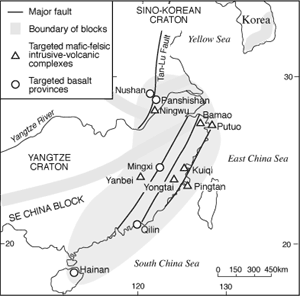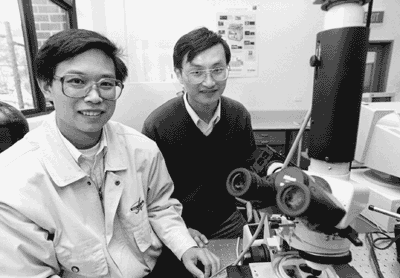GEMOC's international links
- GEMOC has strong international links. These were based dominantly in Asia for the first three years including China, Japan, Mongolia, Myanmar and Thailand) and the former USSR but have been broadened through 1999 to include substantial programs in France, (funded by IREX from 2000), Norway and the USA.
- Targeted Asian regions have geological similarities and contrasts that help us to interpret the geological structure and metallogenic framework of the Australian continent: they provide more easily studied analogues to some of Australia's tectonic terranes.
- The focus of the collaborative research in China shifted during 1999 from the Sino-Korean Craton to southeastern China and Xinjian Province in northwestern China.

At the Nanjing Workshop, November 1999. Left to right: Professor Zhou Xinmin, Professor Yue Jinue, Assoc. Prof Yu Jinhai, Sue O'Reilly, Bill Griffin, Assoc. Prof Wang Xiang, Dr Ming Zhang and Assoc. Prof Xu Xisheng.
examples of active funded projects in Asia
- geophysical analysis of China Geotraverses (including gravity modelling)
- nature and geophysical signature of the lithosphere in southeastern China
- crust-mantle interaction in southeastern China: the origin of the Yanshanian Granites
- trace element and isotopic characteristics of zircon as indicators of granite magma evolution (see Research Highlights)
- nature of the lithosphere in northwestern China ( Tienshan Mountains in Xinjian)
- fundamental terrane boundaries in Japan
- nature of volcanism at collision margins: evidence from deep-sea ashes
- metallogenesis of southeastern China
- basaltic volcanism and basin development, north China
- thermal contrasts and paleogeotherms in Siberia, Mongolia, eastern China
- sapphire occurrences and origin
- diamond exploration, tectonism, and geophysical nature of the lithosphere, Siberia and E. Asia
- mantle terranes and tectonic analysis, Siberia
- Rodinia and Gondwana: dispersal and docking of Australian terranes in Asia

Some of the localities in southeastern China targeted in 1999 for
Lithosphere Mapping and Crustal Generation projects
funded collaborative projects initiated 1999 include:
- Sulfides and the PGE budget in the mantle beneath the Massif Central (with Prof J.-L. Bodinier, University of Montpelier and Prof J.-P. Lorand, National Natural History Museum, Paris).
- Lithosphere structure and composition beneath the Rio Grande Rift (with N. Christensen,
- University of Wisconsin (Madison) and R. Keller, University of Texas).
- Zircon Provenance (using in situ U/Pb dating and Hf isotopic compositions) from North Sea sediments, with Trine-Lise Knudsen (Geologisk Museum, Oslo).
- In situ Sr isotope analysis of marine fossils to constrain stratigraphic/tectonic reconstruction of terranes in New Zealand, with Dr C. Adams (Institute of Geology and Nuclear Sciences, New Zealand).
- Composition and crystal chemistry of mantle amphiboles (with M. Tiepolo, R Vanucci and R. Oberti from the University of Pavia, Italy.
- South American diamonds with Dr Felix Kaminsky (KMD Diamond Exploration, Canada)
- Gravity Modeling (2-D) and integrated modeling of lithosphere structure of the Taiwan-Szechuan section of the Global Geoscience Transect 21 (see picture, page 49). This is a collaborative project with the newly-formed China Geological Survey and the Regional Gravity Centre, Xi'an.
- Bill Griffin edited part of the Tectonophysics Issue for the international project "Continental Growth in the Phanerozoic: Evidence from East-Central Asia" designated IGCP (International Geological Correlation Program) Project 420 (papers from the workshop in Urumqi in 1998).
- A formal Workshop was held in the Department of Earth Sciences, Nanjing University in November 1999 focussed on "Crust-mantle interaction and metallogenesis in southeastern China"
- A new collaboration with Northwestern University, Xi'an was initiated with Dr Lai Shaocong's visit to Macquarie in 1999 to undertake ICPMS and MC-ICPMS analyses of Tibetan basaltic volcanics.
 Xu Xisheng and Yu Jinhai using the Macquarie LAM-ICPMS
Xu Xisheng and Yu Jinhai using the Macquarie LAM-ICPMS
funded collaborative projects ongoing in 1999 include:
- Interpretation of the lithosphere structure of the Global Geoscience Transect 21 with Professor Yuan Xuecheng of the China Geological Survey.
- Drs Pornsawat Wathanakul (Kasetsart University, Bangkok), Visut Pisutha-Arnond (Chalalongkorn University, Bangkok) and Dr Suporn Intasopa (Department of Mineral Resources, Bangkok) continued collaborative work with GEMOC on the genesis of basaltic-hosted corundum (in Thailand).
- Collaboration with Professors A. Giret and J.-Y. Cottin continued between Macquarie University and the University of Jean Monnet, St Etienne. A formal agreement between these two universities includes PhD exchange, academic exchange and research collaboration relevant to the nature of the lithosphere in the Kerguelen Archipelago, Crozet Islands, Hoggar and the Massif Central. Bertrand Moine continued related PhD studies and Guillaume Delpech was awarded a Macquarie University Postgraduate Scholarship from 2000.
- In collaboration with Drs H. Laperre and E. Jaillard of the Institut Dolomieu of the Université Joseph Fourier and CNRS (Grenoble) respectively, Richard Arculus has been involved in studies of the Andean margin of Ecuador.
- Igneous rocks, mineral deposits and tectonic setting: southeastern China and eastern Australia (with Nanjing University led in China by Prof. Zhou Xinmin with reciprocal funding from China sources). This is funded by AusAID under the ACILP scheme and ARC.
- Lithosphere Mapping in eastern China (with a Consortium of participating institutions in a 5-year National Priority Program funded by China NSF from 1997, led in China by Prof Zhou Xinhua of the Geological Institute, Academy of Sciences, Beijing). Results and material from GEMOC's previous International Links Project played a key role in the success of this project funding in China.
- Nature of Siberian Lithosphere part 2 (with WMC)
- Canadian shield lithosphere structure (with Kennecott Canada)
- Thermal and petrologic structure of the Rio Grande Rift and Baja California (with USA partners)
- Deccan plume mantle (with Pune University)
- Kerguelen Archipelago lithosphere structure (with the University of St Etienne)
- Inclusions in diamonds from Canadian lithosphere (with Kennecott Canada)
- Thailand diamonds, sapphires and basalts (with Kasetstart University, Myanmar Ministry of Mines and CSIRO)
- Refer to the Research Program and Postgraduate sections of this Report for details of other collaborative research projects and postgraduate exchanges.
GEMOC participants also have a wide range of other research collaborations
with colleagues in UK, USA, Europe (France, Germany, Norway) as described
in the section on Research Programs and in Appendix
5.

Bertrand Moine, a co-tutelle PhD student with Macquarie and Jean Monnet Universities, using the Macquarie electron microprobe.

 GEMOC ARC National Key Centre
GEMOC ARC National Key Centre